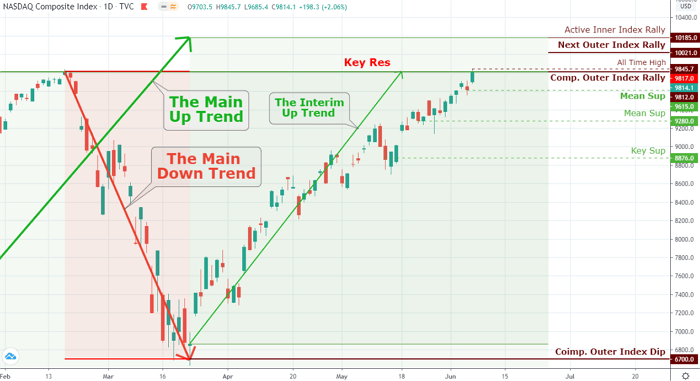Weekly Market Review & Analysis For June 1, 2020

The S&P 500 market advanced 4.9% this week, finishing slightly below the $3,200 price level on the back of recovering economic data, improving optimism, and a FOMO (fear of missing out). The DJI Average posted +6.8%, and small-cap Russell 2000 index printed +8.1% easily outperforming the strength between value and small-cap stocks
|
The heavy-tech Nasdaq Composite index rose 2.1% and established a new intraday high. The index has fully taken back all of its losses after plunging more than 30% since it set its 52-week high on Feb 19; Undoubtedly, this is the quickest turnaround in its history of the markets. For a valid reason, last month's Employment Situation Report drew the most notice this week, as it showed much better than anticipated numbers. |

Click the Image to Enlarge
×
|
Officially nonfarm payrolls rose by 2.509 million, nonfarm private payrolls expanded by 3.094 million, and the civilian unemployment rate declined to 13.3% from April 14.7% reporting.
Market action
The S&P 500 market doubled plus its weekly winnings on Friday session print from +2.2% to +4.9% following job release data, as the numbers implied that recovery was happening much quicker than expected.
All eleven S&P 500 sectors finished the week with robust gains, though it was the cyclical sectors, which stand to profit the most utmost from an improvement in economic movement, which outperformed.
The pounded energy sector posted +15.4%, financials sector printed +12.2%, and industrials sector gained +10.5%, those advanced more than a double-digit percentage. The health care sector earned paltry +0.2%, just barely closing positive for the week.
Other S&P 500 sectors climbed with at least 2.0% showing. The energy stocks were uplifted by the resumed surge in crude oil prices.
Earlier this week, traders and investors continued to grab on positive business updated information from stock market established companies, such as Lyft, Visa, and American Airlines.
American Airlines shares swelled 77% this week, most utmost of which happened after the company published plans to expand its domestic flying schedule for the upcoming summer season on account of improving travel demand. The Boeing Company shares climbed 41%.
In Eurozone, the European Central Bank boosted its pandemic emergency purchase plan by 600 billion euro-dollars to a new total of 1.35 trillion euros. The euro-dollar resumed rising against the U.S. Dollar on expectations for a more robust fiscal union, which continued to add a further weekly decline (1.4%) in the U.S. Dollar Index with the closing of 97.00.
The longer-term U.S. Treasuries market sold off this week, which sent yields noticeably much higher. The benchmarking Ten-year note yield increased 25 bps to 0.91%, while the Two-year note yield widened six bps to finish at 0.21% for the week.